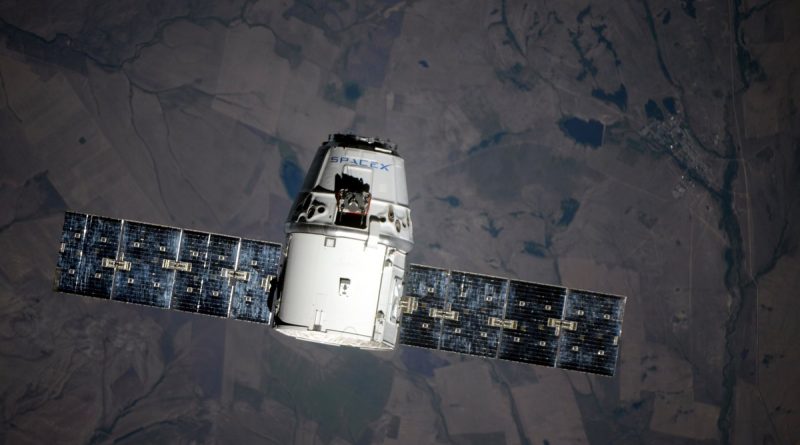Science-Laden Dragon Arrives at Space Station after Flawless Two-Day Rendezvous
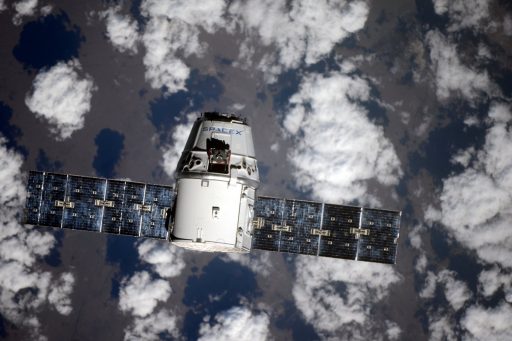
A SpaceX Dragon cargo spacecraft packed to the brink with science gear and supplies parked ten meters from the International Space Station on Wednesday to be captured by the Station’s robotic arm and kick off a five-week stay dedicated to cargo transfers inside and outside the complex and a busy science schedule for what is now a four-person crew on the Station’s U.S. Segment.
The twelfth regular Dragon mission to the ISS – the last in the original Commercial Resupply Services 1 contract with NASA – delivers a total of 2,910 Kilograms of cargo, among which is a new ultra-high-energy particle detector taking up residence outside ISS, several small satellites to be deployed from the complex, a supercomputer set for a year of in-space testing, research that could reveal the mechanism of Parkinson’s disease, artificial Lung Cultures, two groups of mice set for a month-long stay on ISS, and, last but not least, ice cream treats for the Station’s six crew members.
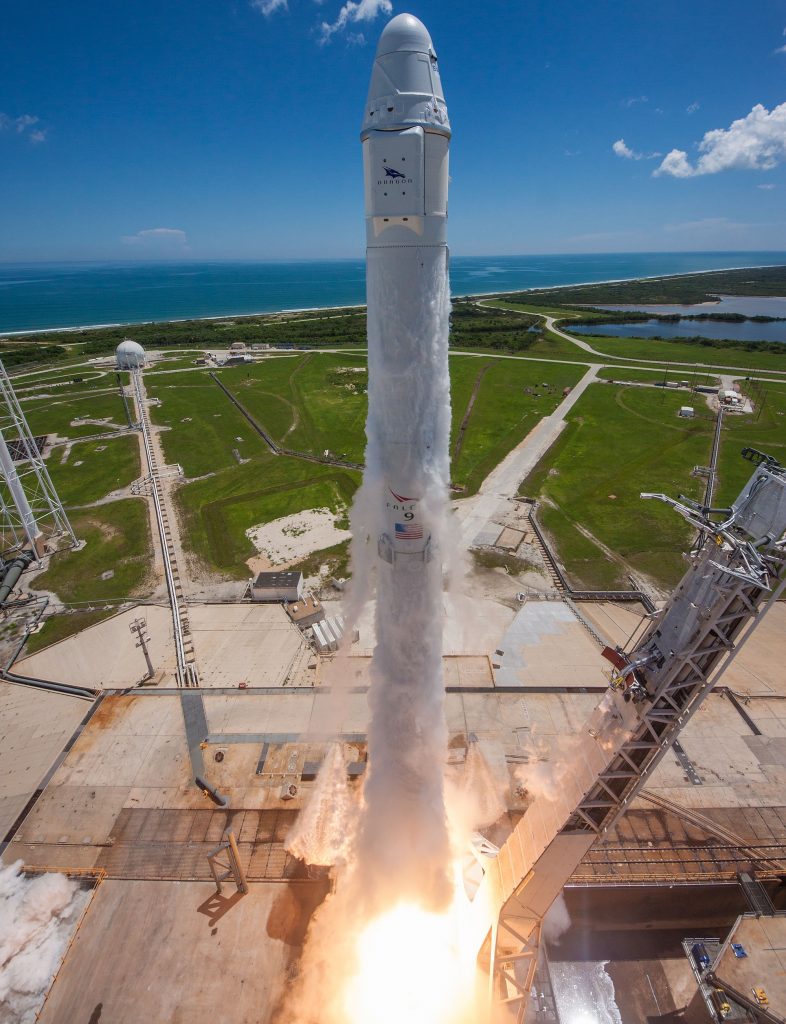
Clockwork appears to be a good descriptor for the Dragon SpX-12 mission so far, starting with an on-time liftoff atop SpaceX’s Falcon 9 rocket at 16:31 UTC on Monday. Thundering off from Launch Complex 39A at Cape Canaveral, Falcon 9 fired its nine first stage engines for two minutes and 25 seconds before the second stage took over for a burn of six and a half minutes to boost Dragon into orbit. Meanwhile, the first stage booster made a rocket-powered U-turn and fired up twice more to set itself down on four previously used landing legs to give SpaceX an additional first stage to be re-used on a future mission.
The 10,600-Kilogram Dragon separated from the rocket’s second stage ten minutes after blasting off, reaching an orbit of 206 by 357 Kilometers, set to catch up with the Space Station from behind and below. Shortly after its spring-loaded separation, Dragon primed its Draco thrusters and deployed its two power-generating solar arrays to head off on a planned 42.5-hour, 27-orbit rendezvous with the Space Station.
Dragon’s climb to the Space Station kicked off less than an hour after liftoff when the spacecraft executed a ~45-meter per second coelliptic burn to circularize its orbit. Next was the opening of the GNC Bay Door to reveal the craft’s grapple fixture and navigation instruments followed by a Height-Adjust & Coelliptic Burn pair Monday night to fine-tune its orbit ten Kilometers below that of the Space Station. By the crew’s bedtime on Tuesday, Dragon had reached a range of 600 Kilometers and was continuing to catch up with ISS from behind and below.

Another HA/CE burn pair, completed in the early hours on Wednesday, put Dragon into an orbit 2.5km below that of ISS and the vehicle entered the 28-Kilometer communications zone around the complex at 6:15 UTC to begin the relative navigation phase of the rendezvous that entails the exchange of navigation data between the approaching spacecraft and ISS to enable more accurate navigation. HE/CE-3 and a pair of mid-course correction burns placed Dragon 1.4 Kilometers below the Space Station, still catching up from behind until the Approach Initiation Burn was performed.
Mission Control confirmed to the ISS crew at 8:09 UTC that the 0.3-meter-per-second Approach Initiation maneuver was successful, transitioning Dragon onto a path to arrive directly below the complex on what is known as the R-bar or radial vector. Dragon acquired the R-bar just before 9 UTC and entered a holding pattern 350 meters directly below ISS to facilitate a 180-degree yaw maneuver to properly position the grapple fixture for capture and point the thrusters to the correct direction for a possible posigrade abort maneuver.
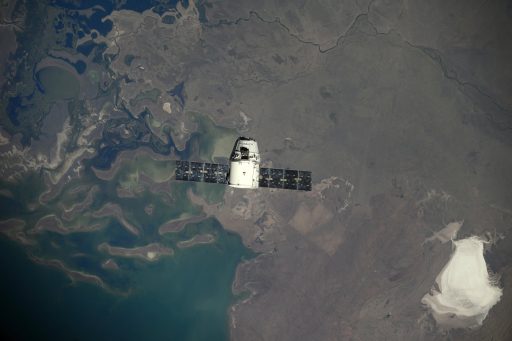
Pulsing its thrusters, Dragon advanced another 100 meters to arrive at the 250-meter hold point, all under the watchful eye of Mission Controllers in Houston and Hawthorne as well as ISS crew members Jack Fischer, getting ready to capture his second Dragon, and Paolo Nespoli, handling communications and commanding of the spacecraft via the COTS Communications Unit that allows the crew to directly send commands to Dragon in case of trouble. During the 15-minute hold at 250 meters, Dragon fired up its Proximity Navigation System to transition from relative GPS to a LIDAR that bounces laser beams off reflectors on ISS for range and rate measurements and a thermal imager that delivers imagery for the calculation of the relative geometry between ISS and Dragon.
The straight-up approach to the next hold point at 30 meters took just over half an hour with Dragon coming to another planned stop to provide time for Fischer and Nespoli to work through the setup for capture while Dragon’s LIDAR was configured for the final approach. The spacecraft continued to be very well behaved and the command for final approach was sent at 10:22 UTC to allow Dragon to slowly move up to the Capture Point just around 11.4 meters from the modules of ISS.
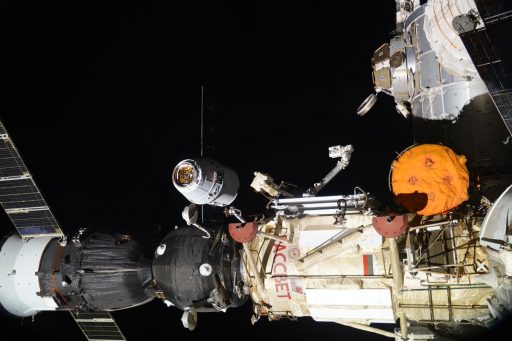
Coming to a hold at the Capture Point, Dragon zeroed out any relative motion between itself and ISS while the crew re-positioned cameras and took the brakes off the robotic arm that had been placed into its high-hover position ahead of the capture point arrival. Mission Control provided the crew with a GO for capture, allowing Fischer and Nespoli to work through the capture checklist at their own pace – putting Dragon into Free Drift as they started moving in with the arm.
At the robotic controls, Fischer used the camera views from the arm and his out-the-window view of the scene to align the Latching End Effector with Dragon’s grapple fixture before pushing in for the capture. Capture was confirmed at 10:52 UTC while ISS and Dragon were flying over 400 Kilometer above New Zealand – marking a rare nighttime capture.
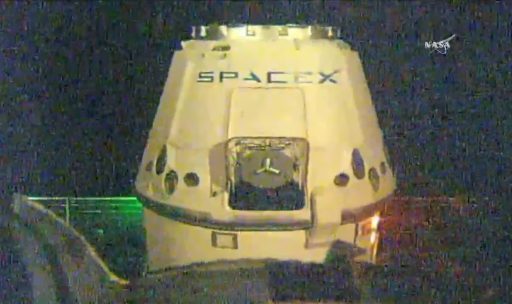
Having arrived after a free flight of 42 hours and 21 minutes, Dragon was successfully tamed and words of congratulations were exchanged between the crew in orbit and the team on the ground, highlighting the critical science cargo aboard the Dragon.
After capturing the spacecraft, the crew handed robotic duties over to ROBO controllers on the ground who will be in charge of berthing the spacecraft to the Earth-facing port of the Harmony module. With Dragon in tow, the 18-meter long Canadarm2 will go through a series of pre-planned maneuvers to first place Dragon at a standoff distance to Harmony for an inspection of its berthing mechanism seals followed by moving Dragon in for berthing – requiring millimeter-precision to obtain four green ready-to-latch indicators that will confirm to teams that Dragon is in position to be bolted down.
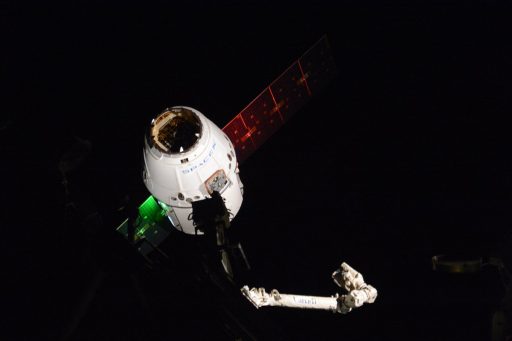
Four Capture Latches will be closed to achieve first stage capture that will secure the Dragon and allow the robotic arm to switch into what is known as limp-mode, giving Dragon some wiggle room to be pulled in by the berthing mechanism bolts. Sixteen bolts will be driven in four gangs of four to tightly pull the Common Berthing Mechanisms together and form a pressure tight seal.
If all stays on the timeline, the crew is very likely to complete the hatch opening on Wednesday to open Dragon for business, in part incentivized by the ice cream stashed in some of the laboratory freezers hosted in Dragon’s pressurized compartment.
Opening of the Harmony hatch will be preceded by the standard leak check to make sure the berthing mechanism is holding pressure. Accessing the vestibule area, the crew will remove Control Panel Assemblies that drive the CBM bolts and install ISS power and data jumpers. Hatch opening on the Dragon will be preceded by pressure equalization and the crew donning protective gear to ensure floating debris, if present inside the vehicle, can not harm the ingressing crew members as they ready Dragon for a planned 35-day stay.
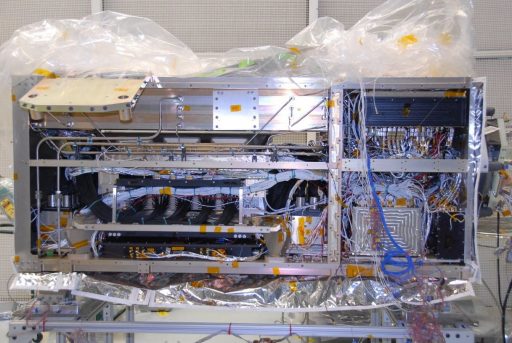
Dragon SpX-12 is setting a new record for the amount of research on an ISS visiting vehicle with 75% of the vehicle’s total cargo load dedicated to experiments and research gear. The spacecraft is loaded with 2,910 Kilograms of cargo, making it one of the heavier Dragons heading to the International Space Station and putting SpaceX’s total CRS-1 cargo upmass to date at 23,800 Kilograms on eleven successful missions.
>>Dragon SpX-12 Cargo Overview
Bolted into the spacecraft’s trunk section is the 1,258-Kilogram Cosmic Ray Energetics and Mass Instrument (CREAM) – the newest addition to the Space Station’s astrophysics instrument suite that, among others, comprises the recently launched NICER studying ultra-dense neutron stars, CALET as a high-energy detector for X- and gamma-rays, and the AMS-2 particle detector as the flagship, having detected its 100 billionth particle earlier this year.
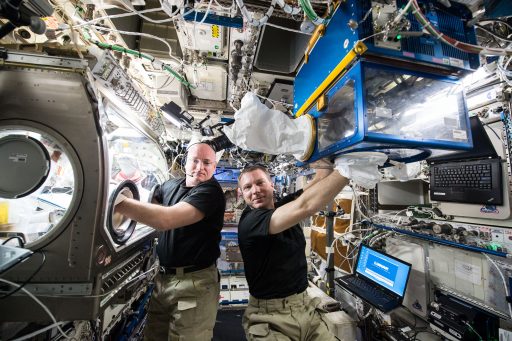
CREAM, housing a stack of five detectors working in unison, is designed to measure ultra-high-energy particles, expanding the AMS-2 energy range by several orders of magnitude to help explain some of the peculiarities in the cosmic energy spectrum – in particular an unexplained decline in the observed spectrum where particle theory would not predict such a decrease, a question that has been puzzling scientists for decades.
1,652 Kilograms of cargo are packed into the pressurized section of the Dragon spacecraft – 916kg of science investigations, 339kg of vehicle hardware, 220kg of crew supplies and 83kg of computer and spacewalk hardware. Riding aboard the Dragon are two groups of mice, one in the U.S.-developed Rodent Habitat and the other using Japan’s Mouse Habitat Unit to participate in a study of musculoskeletal and neurovascular changes brought on by extended stays in microgravity, acting as model organisms for humans and aiding the development for countermeasures needed on future long-duration space missions.
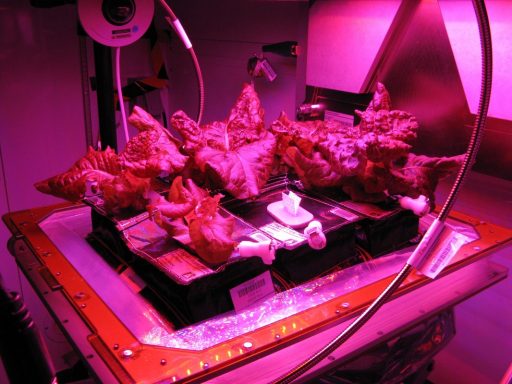
Three powered Polar freezers are aboard the Dragon holding a range of biological samples to be studied in the unique environment offered by the Space Station, though the some space inside the freezers is taken up by ice cream treats for the Station’s six-person crew. Research delivered by the SpX-12 Dragon includes a novel study of a protein implicated in Parkinson’s disease, attempting to grow large, pristine crystals of the target protein to enable scientists on Earth to study its atomic structure and potentially lead to therapies that could prevent, slow or even stop the progression of Parkinson’s.
A supercomputer hitching a ride on the Dragon will operate on ISS for the next year to test out techniques of dealing with in-space radiation through a software algorithm instead of heavy radiation shielding, potentially providing a solution for future onboard computers taking probes and humans into the depths of the Solar System. Other experiments riding on Dragon aim to grow bio-engineered lung tissue, track how potentially harmful microbes spread in space, and examine how plants protect themselves from stress factors encountered in space; also aboard the spacecraft are new plant pillows for the Station’s Veggie facility to continue working on in-space cultivation techniques needed for missions to distant targets.

